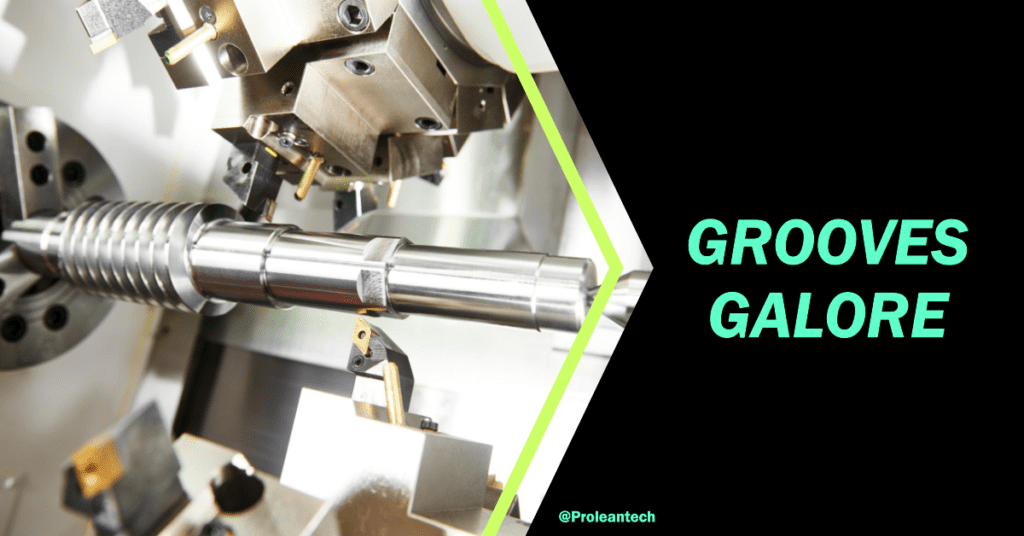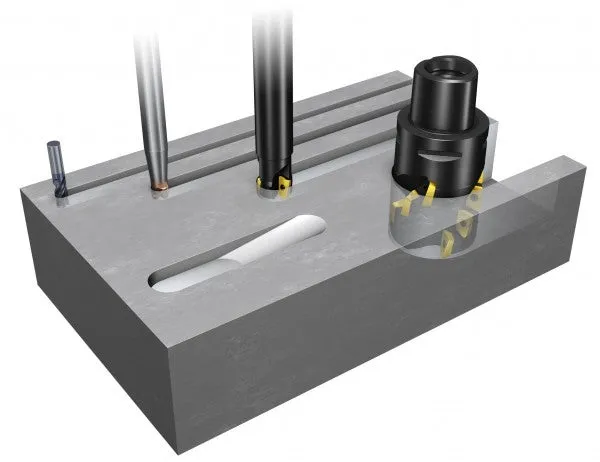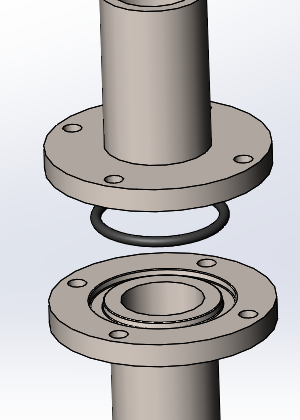
CNC machining is a pivotal player in the manufacturing industry and continues to prove its versatility and precision. One of its noteworthy capabilities lies in the creation of various geometries, specifically grooves. Grooves, vital in many applications, require the utmost precision and consistency that only technologies like CNC machining can provide.
In this comprehensive guide, we’ll delve into the fascinating realm of creating grooves with CNC machining and how Prolean’s CNC machining services can elevate the process.
Grooves: What are They and Why are They Important?

Grooves are often viewed as minute elements of a larger design, grooves are recesses or indentations that are systematically crafted on a surface. They can vary in depth, width, and shape, each feature determining its utility and role within a particular application.
One of the defining characteristics of a groove is its geometry. This could range from simple, straight-walled configurations to more complex shapes like V or U configurations. For instance, in an O-ring application, a rounded groove profile is essential to maintain the integrity of the seal.

O-ring grooving
Grooves perform vital functions across a multitude of industries. In mechanical engineering, they often serve as pathways for lubricants, improving the efficiency and lifespan of moving parts. In electronics, grooves can be used to create pathways for conductive materials, enabling the flow of electricity. The automotive and aerospace sectors also make extensive use of grooves for applications like seat tracks and wing components.
Table 1: Applications of Grooves in Various Industries
| Industry | Application |
|---|---|
| Mechanical Engineering | Lubrication channels |
| Electronics | Pathways for conductive materials |
| Automotive | Seat tracks |
| Aerospace | Wing components |
| Manufacturing | Joining parts together |
How CNC Machining Creates Grooves?
CNC machining has emerged as a reliable and efficient method for creating grooves in a vast array of materials. Its unparalleled precision and repeatability make it ideal for manufacturing parts with complex geometries, including grooves.
Several CNC machining processes can be employed to create grooves, each suited to different applications.
- Milling: One of the most commonly used methods to create grooves is CNC milling. In this process, a rotating cutting tool removes material from the workpiece to create the desired groove geometry. The depth, width, and shape of the groove can be controlled precisely, making milling an extremely versatile technique for groove creation.
- Turning: Another popular method is CNC turning, where the workpiece rotates while the cutting tool, stationary but movable in two axes, carve out the groove. This process is typically used for creating grooves on cylindrical parts.
- Engraving: For extremely intricate or delicate grooves, CNC engraving might be the chosen method. Here, a pointed tool is used to cut into the surface, allowing for the creation of fine lines and intricate details.
Table 2: CNC Machining Processes for Groove Creation
| Process | Characteristics | Suitable for |
|---|---|---|
| Milling | Rotating cutting tool, controllable depth and width | Various materials, diverse groove geometries |
| Turning | Workpiece rotates, tool carves groove | Cylindrical parts |
| Engraving | Pointed tool, intricate detailing | Fine lines and complex patterns |
It’s important to note that the choice of the CNC machining process for creating grooves largely depends on the desired outcome and the specifics of the groove such as its depth, width, and geometry. Additionally, factors such as material type and hardness also play a role in determining the most suitable method for groove creation.
Considerations for CNC Groove Machining
Successfully creating grooves with CNC machining requires careful consideration of several factors. These factors range from tool selection and operating parameters to specific groove characteristics.
- Tool Selection: The choice of tooling is crucial. Different tools are better suited for certain groove types. For instance, a tool with a round nose may be best for creating round-bottomed grooves, while a tool with a square tip may be used for square-bottomed grooves.
- Operating Parameters: These include feed rate, spindle speed, and depth of cut. Selecting appropriate operating parameters can help achieve the desired groove characteristics while ensuring efficient machining.
- Groove Characteristics: The dimensions and geometry of the groove must be accurately defined. It’s important to consider the width, depth, and profile of the groove as these characteristics will dictate the tooling and machining parameters.
Types of CNC Grooving Tools
CNC grooving tools come in various types, each designed to perform a specific function or create a certain type of groove. Some of the common types include:
- Parting Tools: Used to cut deep grooves that part off a completed component from the main workpiece.
- External Grooving Tools: Used to machine grooves on the external surface of a workpiece.
- Internal Grooving Tools: Designed to machine grooves inside holes or other internal surfaces.
- Face Grooving Tools: Used to create grooves on the end face of a workpiece.
Table 3: Types of CNC Grooving Tools
| Type of Tool | Function |
|---|---|
| Parting Tools | Cutting deep grooves to part off a completed component |
| External Grooving Tools | Machining grooves on external surfaces |
| Internal Grooving Tools | Machining grooves on internal surfaces |
| Face Grooving Tools | Creating grooves on the end face of a workpiece |
How to Choose the Right Tool?
Selecting the right tool requires considering factors like the type of groove, the material of the workpiece, tool material, cutting parameters, and the CNC machine’s capabilities. Consulting with a CNC machining expert or tooling specialist can provide valuable guidance in tool selection.
By understanding your CNC machining needs and selecting the right tool, you can ensure a successful and efficient grooving process. As a comprehensive CNC machining service provider, Prolean can assist you in not only creating high-quality grooves but also in choosing the appropriate tools and techniques for your machining needs.
Advantages of Using CNC Machining for Creating Grooves
There are several reasons why CNC machining is a preferred choice for creating grooves:
- Precision and Accuracy: CNC machining can create grooves with high levels of precision and accuracy, which is crucial for ensuring the functionality of the grooved component.
- Versatility: With CNC machining, it’s possible to create various groove geometries, including straight, curved, spiral, and more.
- Repeatability: CNC machines can produce identical parts over and over again. This is especially beneficial in mass production scenarios where consistency is key.
- Speed: CNC machines, guided by programmed instructions, work faster than manual machining processes, resulting in faster production times.
- Material Versatility: CNC machines can handle a wide range of materials, from metals to plastics, which widens their applicability in various industries.
Remember, creating grooves is an art that requires an understanding of both the design requirements and the capabilities of the CNC machine.
Challenges and Solutions in CNC Groove Machining
Despite the many advantages that CNC machining offers, creating grooves does present a few challenges. However, with careful planning and execution, these challenges can be effectively mitigated. Let’s explore some of the common challenges and their solutions:
- Chip Evacuation
During the machining of grooves, chip evacuation can be problematic. If not properly managed, chips can clog the groove, causing tool wear or breakage.
- Solution: Using a tool with a proper chip breaker design, combined with appropriate coolant usage, can help in effective chip evacuation.
- Tool Access
Depending on the depth and accessibility of the groove, getting the tool in place can be difficult.
- Solution: Using specialized grooving tools or tool holders, designed to reach deeper or narrower grooves, can mitigate this challenge.
- Surface Finish
Achieving a smooth surface finish inside the groove can be challenging due to vibration or tool deflection.
- Solution: This can be overcome by optimizing machining parameters such as speed, feed, and depth of cut, as well as using high-quality tools with a rigid setup.
Table 4: Challenges and Solutions in CNC Groove Machining
| Challenge | Solution |
|---|---|
| Chip Evacuation | Use a tool with a proper chip breaker design and apply coolant effectively |
| Tool Access | Use specialized grooving tools or tool holders |
| Surface Finish | Optimize machining parameters and use high-quality, rigid tools |
Conclusion
CNC machining offers a versatile and precise method for creating grooves in a variety of materials. It allows for complex geometries and tight tolerances, making it an ideal choice for many industries. However, mastering CNC groove machining requires understanding the challenges and knowing how to overcome them. With the right tools and techniques, CNC machining can create efficient, high-quality grooves tailored to your specific needs.
At Prolean, we offer top-notch CNC machining services. Our team of skilled professionals leverages advanced machining techniques to deliver high-quality, precise grooved components that align perfectly with your requirements. Contact us today for all your CNC machining needs.
FAQs
What types of grooves can be machined using CNC?
CNC machining can create a variety of grooves, including straight, curved, and spiral grooves. The geometry of the groove depends on the tool used and the programming of the CNC machine.
Can CNC machines create grooves in all types of materials?
CNC machines can handle a wide variety of materials, including different types of metals and plastics. The choice of material depends on the application and the properties required for the grooved component.
What factors should I consider when machining grooves with CNC?
Important considerations include tool selection, operating parameters, and groove characteristics (like depth, width, and profile).
What are the main challenges in CNC groove machining?
Common challenges include chip evacuation, tool access, and achieving a smooth surface finish inside the groove. These can be mitigated with appropriate tool design, tool holders, and optimization of machining parameters.
Can I use Prolean’s CNC machining services for creating grooves?
Absolutely. At Prolean, we specialize in CNC machining and can deliver high-quality, precise grooves in a variety of materials, customized to your specific needs.




0 Comments